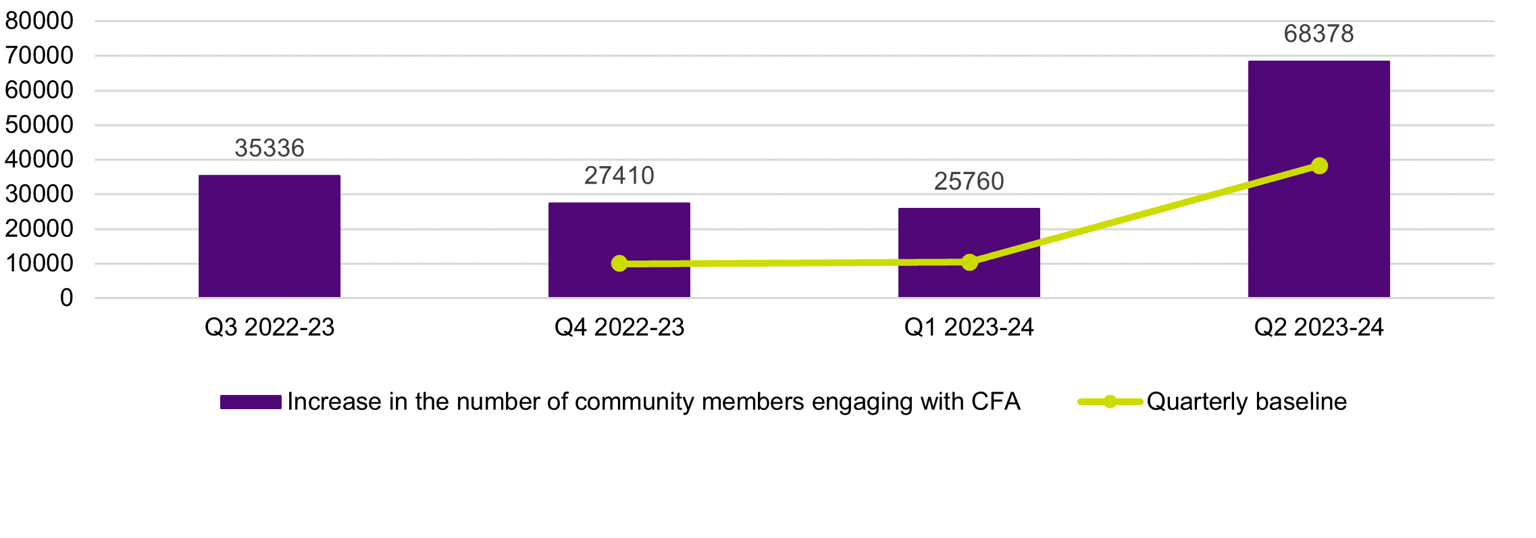2.1.1 FRV: Number of sessions of FireEd and risk reduction programs delivered to the community
The FRV FireEd program provides home fire safety education to primary school children in order to embed lifelong practices that reduce fire risks in the home.
FRV delivered 264 FireEd and risk reduction programs in Q2. This is a 21.1 per cent increase compared to the previous quarter Q1 2023-24 (218) and demonstrates a notable achievement (Figure 1). FRV advised a combination of factors contributed to this result, including improvements to internal risk reduction program reporting and an increase in the delivery of risk reduction programs scheduled towards the end of the 2023 calendar year.
FRV expects a year-on-year increase in the number of FireEd sessions delivered as schools become more familiar with the program.
FRV report anecdotal evidence suggests children have used lessons learned from FireEd programs when a fire has occurred in the home. FRV note that an increase in sessions delivered may correlate to a decrease in some house fires, property damage and loss of life. FRV also notes that these reported impacts are not measurable in the short-term but over a longer period of time.
Data note
Q2 2022-23 and Q3 2022-23 data is unavailable due the impact of the December 2022 cyber-attacks on reporting.
2.1.2 CFA: increase in the number of community members engaging with CFA
CFA reported engaging with a total of 68,378 community members in Q2. This result demonstrates a notable achievement considering the significant increase against CFA’s quarterly baseline of more than 30,000 community members engaged this quarter (Figure 2). This result includes the total number of community members engaging with the CFA through the CFA Fire Safety Essentials Program, CFA Fire Safety Planning Workshops, visits to properties in high-fire risk areas, CFA representation at community events, CFA care-sector engagement and CFA school education and fire drill programs. CFA also attributes this higher level of engagement partly to CFA Brigade engagement activities returning to pre-COVID levels, such as through CFA Open Days.
CFA reported they are unable to show a causal relationship between the increased levels of community engagement and changes to performance indicators on fire prevention and community impact. CFA report that an evaluation of their community engagement activities shows that each activity is effective in increasing awareness of fire risk and assisting communities to plan for survival in both home fire and bushfire. CFA also note there is an international body of evidence that shows the benefits to community safety (e.g. reduced risk of dying from house fires and reduced frequency and severity of residential structure fires) from home smoke alarm installation and maintenance1 and public door knocking and community education programs by firefighters2.
Footnotes
[1] FEMA (2008), USFA Position Paper – Residential Fire Sprinklers. http://www.residentialfiresprinklers.com/wpcontent/uploads/2015/06/sprinkler_position_paper.pdf
[2] Clare et al (2013), Reduced frequency and severity of residential fires following delivery of fire prevention education by on-duty fire fighters: Cluster randomized controlled study. https://www.sciencedirect.com/science/article/pii/S0022437512000230#aep-abstract-id6
Updated

